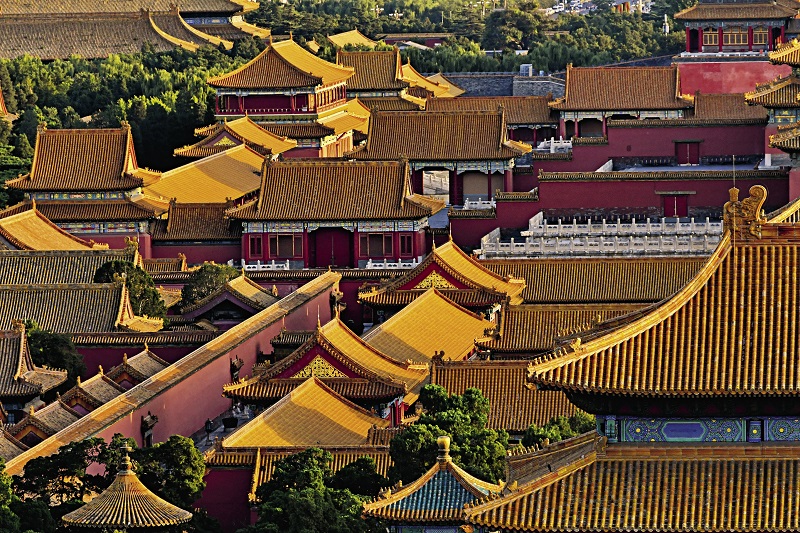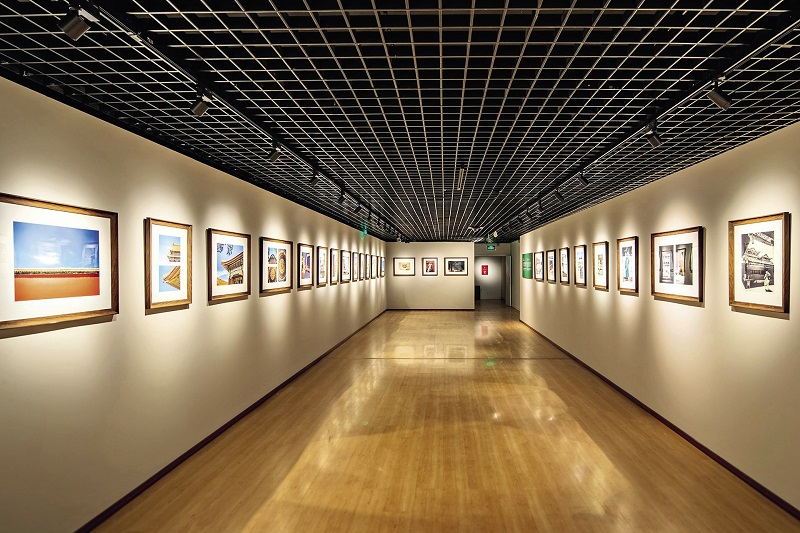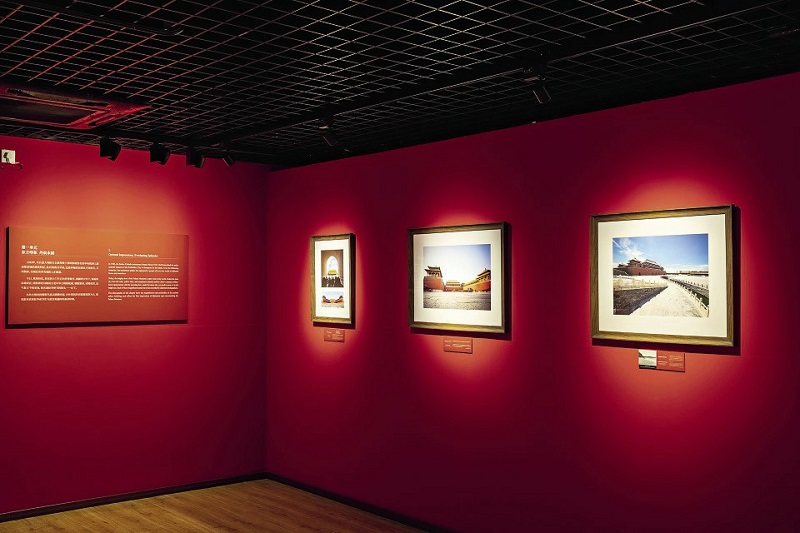A look at the grand Palace Museum of China through foreign diplomats’ photography.

Located in the center of Beijing, the Palace Museum, historically and artistically one of the most comprehensive museums in China, is located on the original site of the Forbidden City, a palace of the Ming and Qing dynasties.
“The sundial was an important instrument to keep track of time in ancient China. Western clocks and watches began to enter the Chinese royal palace in the late Ming Dynasty (1368-1644), and to date, there are more than 1,000 Western timepieces collected at the Palace Museum of China.”
“The past and the present, East and West…all intertwined to bear witness of time.”
These sentences come from captions at the photography exhibition titled “As We Encounter in Light: The Palace Museum through Diplomats’ Eyes.” The first caption is for a close-up photo of a sundial, and the second goes with a photo depicting Douglas Noble, the UNICEF deputy representative to China and the photographer of the first exhibit, looking at his watch in front of the sundial.
The exhibition was held from October 12, 2021 to February 12, 2022 at the Palace of Prolonging Happiness (Yanxi Gong) in Beijing’s iconic Forbidden City, also known as the Palace Museum. Taken by foreign diplomats, the photographs show great examples of history, and also share fun stories inside the walls of the world-famous tourist attraction.

The Palace Museum through the lenses of foreign diplomats takes on a different look.
Many Perspectives
“Time is eternal in the world we live in,” said Douglas Noble, describing what inspired him to take the photos on display. “My initial thought was to compare the ancient timepieces here with modern ones.”
As the UNICEF deputy representative to China, Noble believes that education is foremost for children and teenagers. “The Palace Museum is such a good place to learn more about art, history, and archeology,” he said, explaining why it is his favorite historical setting in China.
Bruno Abreu, a member from the Brazilian Embassy in China, echoed Noble’s sentiments. In 2019, while he was visiting the Palace Museum with his wife, his camera accidentally captured an interesting moment with a tourist guide. “He was like a warrior to me at that moment, leading his group, with their backpacks, flags and headphones. They all looked so proud that they were there visiting,” said Abreu. He captioned his entry in the photo exhibition “Proud,” because he also felt proud the first time he visited the Palace Museum.
Like most foreign diplomats, Fernando Lugris, ambassador of Uruguay to China, has visited the Forbidden City many times. During his six years in Beijing, he has found each visit brings a different experience. “What surprises me most is that I can always discover something new every time I came here,” he said.
Lugris likes taking pictures of the Palace Museum’s magnificent buildings, and is deeply impressed by the maintenance work there. “People are doing such a good job restoring and preserving the ancient buildings. I am really in awe.”
Guo Xinyue, a staff worker from the Palace Museum’s digital and information department, is the curator of the exhibition, quite familiar with the photographs on display.
“We found that as each photographer became familiar with the Forbidden City, they began to express themselves from different perspectives. Their choice of the views and photography techniques is undoubtedly influenced by their own culture, and even their mood, and as a result, in everyone’s eyes, the Forbidden City is different.”
Other participating photographers were Natthira Krasaesarn of the Thai embassy who walked into the Forbidden City and captured her first glimpse of the “Forbidden City in Frame,” and Marc Op De Weerdt of the Belgian embassy who photographed the “Boundless Forbidden City.” The Palace Museum shows its unique charm through various lenses of the diplomats to China.
Even more interesting is the location of the exhibition, the Palace of Prolonging Happiness. The palace was built in the 18th year (1420) of the Yongle reign in the Ming Dynasty, and destroyed by a fire in the 25th year (1845) of the Daoguang reign in the Qing Dynasty. In the first year (1909) of the Xuantong reign, the present building was built on the original site, which was called “Lingzhao Xuan.” The Western-style building has tiles from Germany and several beams from Great Britain. As the exhibition hall of the current photography exhibition, it is once again acting as a bridge connecting Eastern and Western cultures.

Pictures taken by foreign diplomats at the exhibition show both the grand history and unique stories of the Palace Museum.
Facilitating Cultural Exchanges
According to Yuan Hong, a staff worker from the Palace Museum’s international exchanges department, the Palace Museum has held activities connected to diplomats every year since 2012, in line with its own various themed exhibitions.
For example, during the special exhibition about peony-related relics in 2016, diplomats were invited to visit the Palace Museum. During the Spring Festival of 2019, diplomats were also invited to attend the exhibitions on Chinese New Year customs, folk culture, and time-honored homegrown brands. In 2020, at a cultural salon held in the Palace Museum for diplomats, Wang Xudong, director of the museum, gave a lecture on cultural exchanges and mutual learning among different civilizations using the Dunhuang Museum and the Palace Museum as examples.
“Previously I thought the [museum] restorers must be old, but when I entered the restoration room, I saw several young faces,” said Kuzina Anna, director of the culture department of the Russian embassy in China, after visiting the Palace Museum. She applauded the young generation who were devoted to restoring and preserving cultural relics in the museum.
Szonja Buslig, counselor of the Hungarian embassy in China, is an archaeologist. When visiting the bronze restoration room, she said, “China’s methods and standards of cultural relics restoration are not quite the same as ours, which is very inspiring.” She hoped that more Chinese cultural relics would be on display in Hungary, and that the two countries would carry out more cultural exchanges.
The invitation of foreign diplomats to take and contribute photos about the Forbidden City for exhibition received positive responses.
“Diplomats applied enthusiastically to be part of the exhibition on June 17 when we invited them to the museum for shooting. On that day alone, there were more than 70 diplomats participating, and later, more than 200 pictures were submitted to us,” said Yuan Hong. “Such activities not only provide the diplomats with more opportunities to express themselves and have deeper reflections and understanding of traditional Chinese culture, but also enable us to better understand their views on us, thus can promote cultural communication and mutual learning.”
Promoting Chinese Culture Globally
During the past 10 years, the activities of inviting diplomats into the Palace Museum have greatly enhanced the interaction and communication between the Palace Museum and embassies and international organizations in China, promoting cultural exchanges and cooperation between China and other countries.
According to Yuan Hong, during the preparation and organizing of the exhibition – “Across the Silk Road: Gupta Sculptures and Their Chinese Counterparts during 400-700 AD,” Shri Vijay Gokhale, then Indian ambassador to China, and his colleagues all paid close attention. They not only closely followed the progress of the preparation work, but also helped to communicate with relevant Indian departments involved in the exhibition, providing great assistance for its success. In addition, Gokhale also promoted the exhibition on various bilateral occasions.
Moreover, the Palace Museum has cooperated with the Grimaldi Forum of Monaco to hold two exhibitions, one on the emperors of China’s Qing Dynasty, and the other about the 700-year history of Monaco’s House of Grimaldi by exploring its art and artifacts.
During the preparation of the two exhibitions, Catherine Fautrier, then ambassador of Monaco to China, inspected and coordinated the exhibitions in person, and helped with the entry and exit procedures for endangered items among the exhibits. Thanks to the efforts of Fautrier and her coworkers, both exhibitions were successfully. Prince Albert II of Monaco participated in the opening of the two exhibitions, creating a memorable moment in the history of friendly exchanges between the two countries.
Today, diplomats to China have become new voices to promote Chinese culture internationally.
In 2021, diplomats and journalists from ASEAN member states including Cambodia, Indonesia, Laos, Malaysia, the Philippines, Thailand, and Vietnam attended a field trip under the theme of jointly building the 21st century maritime silk road. It was the seventh time the field trip was held. After taking a look at the unique landforms of the ancient Silk Road corridor in Gansu Province, Dewi Avilia, first secretary of the Indonesian Embassy in China said, “Gansu is so beautiful that it is like traveling back to the golden age of the ancient Silk Road.”
Yuan Hong said that in recent years, foreign embassies in China have initiated, assisted with and participated in more and more cultural cooperation projects. “[These include] the exchange exhibitions with Greece in 2018 and the exchange exhibitions with Portugal in 2018-2019, in which embassies played an important role,” he said.
In the future, the Palace Museum plans to launch more colorful activities for foreign diplomats in China to provide them with the opportunity to experience the essence of traditional Chinese culture.